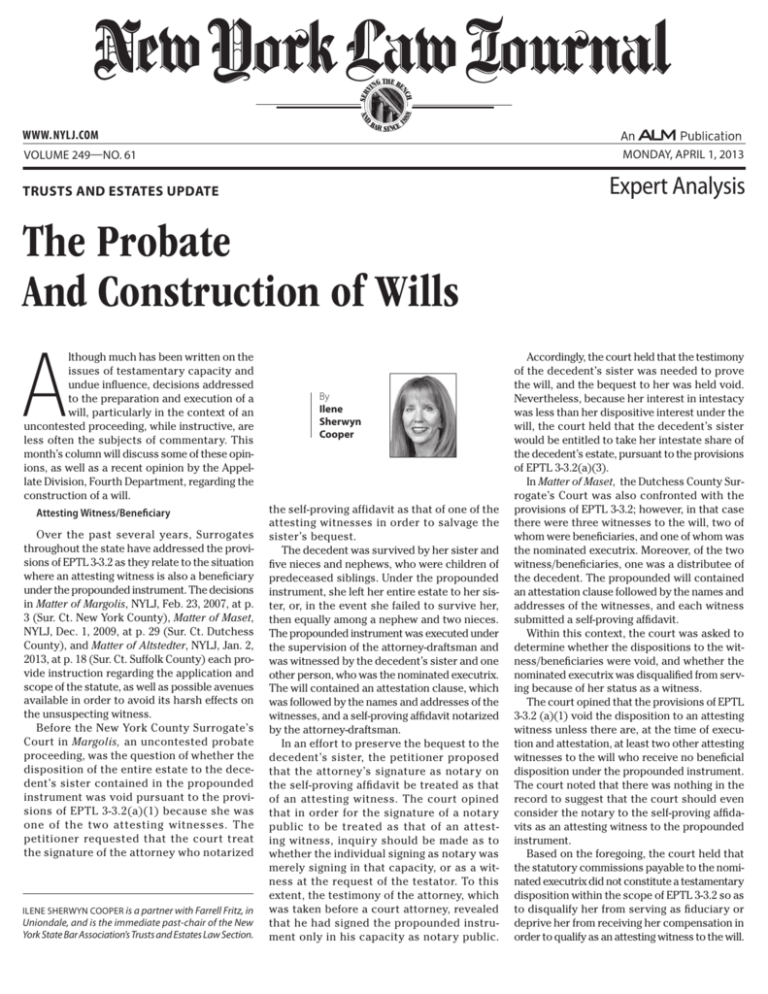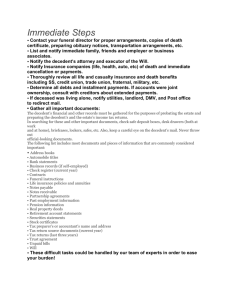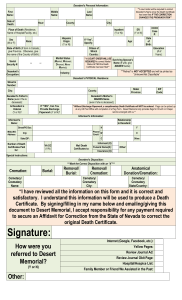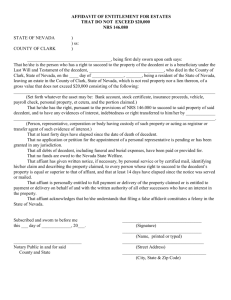
AND
88
8
SER
V
H
NC
THE BE
ING
1
BA
R SINCE
WWW. NYLJ.COM
MONDAY, APRIL 1, 2013
VOLUME 249—NO. 61
Expert Analysis
TRUSTS AND ESTATES UPDATE
The Probate
And Construction of Wills
A
lthough much has been written on the
issues of testamentary capacity and
undue influence, decisions addressed
to the preparation and execution of a
will, particularly in the context of an
uncontested proceeding, while instructive, are
less often the subjects of commentary. This
month’s column will discuss some of these opinions, as well as a recent opinion by the Appellate Division, Fourth Department, regarding the
construction of a will.
Attesting Witness/Beneficiary
Over the past several years, Surrogates
throughout the state have addressed the provisions of EPTL 3-3.2 as they relate to the situation
where an attesting witness is also a beneficiary
under the propounded instrument. The decisions
in Matter of Margolis, NYLJ, Feb. 23, 2007, at p.
3 (Sur. Ct. New York County), Matter of Maset,
NYLJ, Dec. 1, 2009, at p. 29 (Sur. Ct. Dutchess
County), and Matter of Altstedter, NYLJ, Jan. 2,
2013, at p. 18 (Sur. Ct. Suffolk County) each provide instruction regarding the application and
scope of the statute, as well as possible avenues
available in order to avoid its harsh effects on
the unsuspecting witness.
Before the New York County Surrogate’s
Court in Margolis, an uncontested probate
proceeding, was the question of whether the
disposition of the entire estate to the decedent’s sister contained in the propounded
instrument was void pursuant to the provisions of EPTL 3-3.2(a)(1) because she was
one of the two attesting witnesses. The
petitioner requested that the court treat
the signature of the attorney who notarized
ILENE SHERWYN COOPER is a partner with Farrell Fritz, in
Uniondale, and is the immediate past-chair of the New
York State Bar Association’s Trusts and Estates Law Section.
By
Ilene
Sherwyn
Cooper
the self-proving affidavit as that of one of the
attesting witnesses in order to salvage the
sister’s bequest.
The decedent was survived by her sister and
five nieces and nephews, who were children of
predeceased siblings. Under the propounded
instrument, she left her entire estate to her sister, or, in the event she failed to survive her,
then equally among a nephew and two nieces.
The propounded instrument was executed under
the supervision of the attorney-draftsman and
was witnessed by the decedent’s sister and one
other person, who was the nominated executrix.
The will contained an attestation clause, which
was followed by the names and addresses of the
witnesses, and a self-proving affidavit notarized
by the attorney-draftsman.
In an effort to preserve the bequest to the
decedent’s sister, the petitioner proposed
that the attorney’s signature as notary on
the self-proving affidavit be treated as that
of an attesting witness. The court opined
that in order for the signature of a notary
public to be treated as that of an attesting witness, inquiry should be made as to
whether the individual signing as notary was
merely signing in that capacity, or as a witness at the request of the testator. To this
extent, the testimony of the attorney, which
was taken before a court attorney, revealed
that he had signed the propounded instrument only in his capacity as notary public.
Accordingly, the court held that the testimony
of the decedent’s sister was needed to prove
the will, and the bequest to her was held void.
Nevertheless, because her interest in intestacy
was less than her dispositive interest under the
will, the court held that the decedent’s sister
would be entitled to take her intestate share of
the decedent’s estate, pursuant to the provisions
of EPTL 3-3.2(a)(3).
In Matter of Maset, the Dutchess County Surrogate’s Court was also confronted with the
provisions of EPTL 3-3.2; however, in that case
there were three witnesses to the will, two of
whom were beneficiaries, and one of whom was
the nominated executrix. Moreover, of the two
witness/beneficiaries, one was a distributee of
the decedent. The propounded will contained
an attestation clause followed by the names and
addresses of the witnesses, and each witness
submitted a self-proving affidavit.
Within this context, the court was asked to
determine whether the dispositions to the witness/beneficiaries were void, and whether the
nominated executrix was disqualified from serving because of her status as a witness.
The court opined that the provisions of EPTL
3-3.2 (a)(1) void the disposition to an attesting
witness unless there are, at the time of execution and attestation, at least two other attesting
witnesses to the will who receive no beneficial
disposition under the propounded instrument.
The court noted that there was nothing in the
record to suggest that the court should even
consider the notary to the self-proving affidavits as an attesting witness to the propounded
instrument.
Based on the foregoing, the court held that
the statutory commissions payable to the nominated executrix did not constitute a testamentary
disposition within the scope of EPTL 3-3.2 so as
to disqualify her from serving as fiduciary or
deprive her from receiving her compensation in
order to qualify as an attesting witness to the will.
MONDAY, APRIL 1, 2013
Moreover, in the exercise of its discretion, and
in the interests of justice, the court dispensed
with the testimony of one of the witness/beneficiaries, concluding that he should not have to
forfeit, through no fault of his own, the modest
monetary bequest that the decedent wanted him
to receive. Instead, the court held that the testimony of the second witness/beneficiary, who
was also a distributee of the deceased, would
be required for probate, for the “practical” reason that although the dispositions to her under
the will were void, she would nevertheless be
entitled to receive the lesser of those bequests
or her intestate share.
Most recently, the Suffolk County Surrogate’s
Court in Altstedter was confronted with a novel
issue under EPTL 3-2.2 addressed to whether a
beneficial disposition to an entity under a propounded instrument will be void when employees
of the entity were utilized as attesting witnesses.
Pursuant to the provisions of Article Fourth
of the propounded instrument in Altstedter, the
decedent bequeathed $150,000 to the Peconic
Landing Community Fund for the unrestricted use
by the fund directors. In Article Fifth of the instrument, the decedent bequeathed $100,000 to the
Peconic Landing Employees Appreciation Fund.
All three witnesses to the will were employees
of Peconic Landing at the time of its execution.
In support of his request that the provisions
of Articles Fourth and Fifth remain unaffected
by the provisions of EPTL 3-3.2, the petitioner
submitted documents to the court, including,
inter alia, a description of the Community Fund
and the Peconic Landing Resident Handbook.
From these documents, the court found that
because the exclusive purpose of the Community Fund was to benefit residents of Peconic
Landing, there was no beneficial disposition to
the attesting witnesses to the will which would
cause the bequest to the fund to fail.
On the other hand, based upon its review of
the Resident Handbook, the court determined
that because the monies contributed to the
Employees Appreciation Fund could be utilized
for the benefit of the three attesting witnesses
to the will, the disposition to the fund was void
pursuant to EPTL 3-3.2(a)(1) and (2).
‘Sign at the End’ Requirement
Pursuant to the provisions of EPTL 3-2.1,
the statute setting forth the requirements for
due execution, every will must be “signed at
the end thereof by the testator…” In Matter
of Mobley, NYLJ, March 20, 2009, p. 35 (Sur.
Ct. New York County), the court was asked to
determine whether the will of the decedent
comported with the statutory criteria when
the signature of the testator appeared after
the body of the will, the attestation clause
and the signature of the attesting witnesses,
as well as a pre-printed affidavit of attesting witnesses, which had not been signed
by the witnesses.
The propounded instrument was a two-page
form document, which had typed provisions
and handwritten additions. Although the document had two lines on it after the dispositive
provisions that were intended for the signature
of the testator, these lines were blank. Instead,
following the attestation clause, and the signature of the witnesses, the testator signed
on one of the blank spaces appearing on the
self-proving affidavit affixed to the instrument.
Over the past several years, Surrogates
have addressed the provisions of EPTL
3-3.2 as they relate to the situation
where an attesting witness is also a
beneficiary.
The court opined that a will can be admitted
to probate as long as the statutory formalities
are complied with, even if the procedure for
execution and attestation do not take place
in the order set forth in EPTL 3-2.1. To this
extent, the court noted that a testamentary
instrument will not be invalid if the witnesses’
signatures appear before the signature of the
testator. Indeed, the court held that the statutory requirement that the testator “sign at the
end” of the instrument is not violated despite the
fact that the testatrix affixes her signature after
the attestation clause and the signatures of the
attesting witnesses, so long as the dispositive
material precedes the signature of the testator
in order to prevent the possibility of fraudulent
additions to the instrument.
Accordingly, based upon the proof submitted,
the court admitted the propounded instrument
to probate.
Matter of Mobley, NYLJ March 20, 2009, at p.
35 (Sur. Ct. New York County)
Extrinsic Evidence
In Matter of Phillips, the Appellate Division,
Fourth Department, modified an Order of the
Surrogate’s Court, Erie County, which granted
respondent’s cross-motion for summary judgment, and remanded the matter for further proceedings on the issue of the construction of the
decedent’s will.
The record revealed that the decedent’s will
left his estate to his three daughters and to his
live-in girlfriend. In pertinent part, his estate
consisted of his home, and the lot on which it
was situated, and 88 acres of farmland adjacent
to the lot. In Article Four of his will, the decedent bequeathed his residence, and the “plot
of land appurtenant thereto” to his girlfriend,
and the balance of his estate in equal shares to
his daughters.
In her proceeding for construction of the
instrument, one of the decedent’s daughters
sought a determination that the bequest of the
decedent’s home included only the land on which
it was situated, and not the adjacent farmland.
Petitioner attached extrinsic evidence supporting the proposed construction. Respondent,
girlfriend of the decedent, opposed the petition, and more particularly petitioner’s use of
extrinsic evidence to support her application,
contending that the will was clear and unambiguous that she was entitled to the decedent’s
home, lot and farmland. Both sides moved for
summary judgment, and the Surrogate found for
the respondent, concluding that the decedent’s
intent could be inferred from the will, and that
reference to extrinsic evidence was improper.
The Appellate Division disagreed. The court
opined that while the best indicator of a testator’s intent will generally be found within the
four corners of the will, where a provision in
the instrument is ambiguous, extrinsic evidence
is properly considered in determining intent.
The court noted that while the definition of
the term “appurtenant” suggests something
incidental, that does not have an independent
existence, the intent of the testator in utilizing
that term in his will could not be gleaned by
reliance on a dictionary, but rather from the
context in which the will was created. To this
extent, the court held that the provisions of
the will were unclear as to what the decedent
intended. Indeed, the court found that the submissions of the parties raised issues of fact
concerning the decedent’s intent.
Specifically, the court noted that the evidence offered by the petitioner consisting of
the deposition of the attorney-draftsman, and
a questionnaire completed by the decedent suggested that the decedent intended his girlfriend
to only receive his home and the plot of land
on which it stood, while the evidence submitted by the decedent’s girlfriend indicated that
when the decedent originally purchased the lot
and farmland it consisted of one parcel, and the
decedent partitioned the parcel only in anticipation of his impending divorce. Additionally, the
respondent asserted that the utilities located
on the farmland were attached to the meters
located inside the residence.
Accordingly, the court concluded that the parties should be given the opportunity to present extrinsic evidence at a hearing before the
Surrogate regarding the decedent’s intended
distribution.
Matter of Phillips, 101 A.D.3d 1706 (4th Dept.
2012).
Reprinted with permission from the April 1, 2013 edition of the NEW YORK LAW
JOURNAL © 2013 ALM Media Properties, LLC. All rights reserved. Further duplication
without permission is prohibited. For information, contact 877-257-3382 or reprints@alm.
com. # 070-04-13-07






